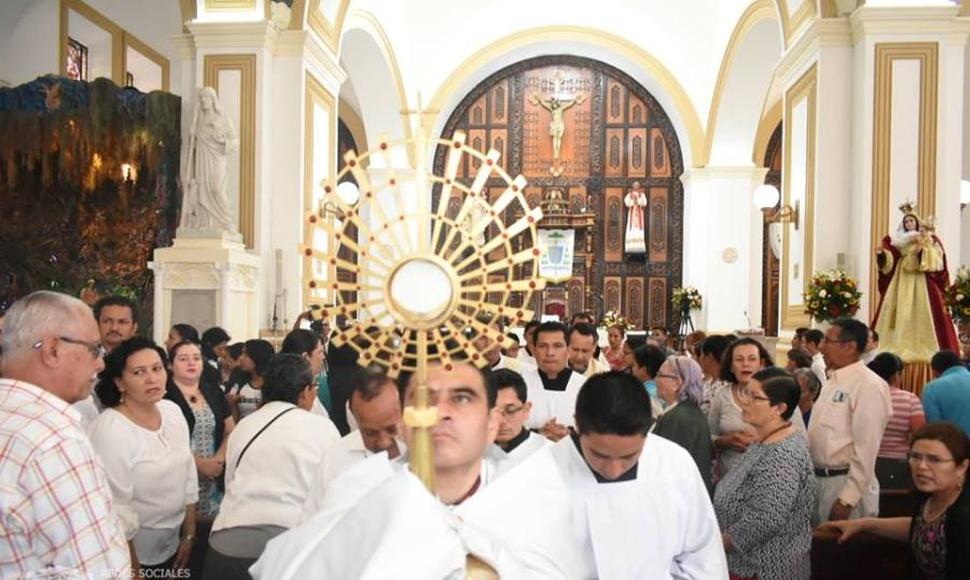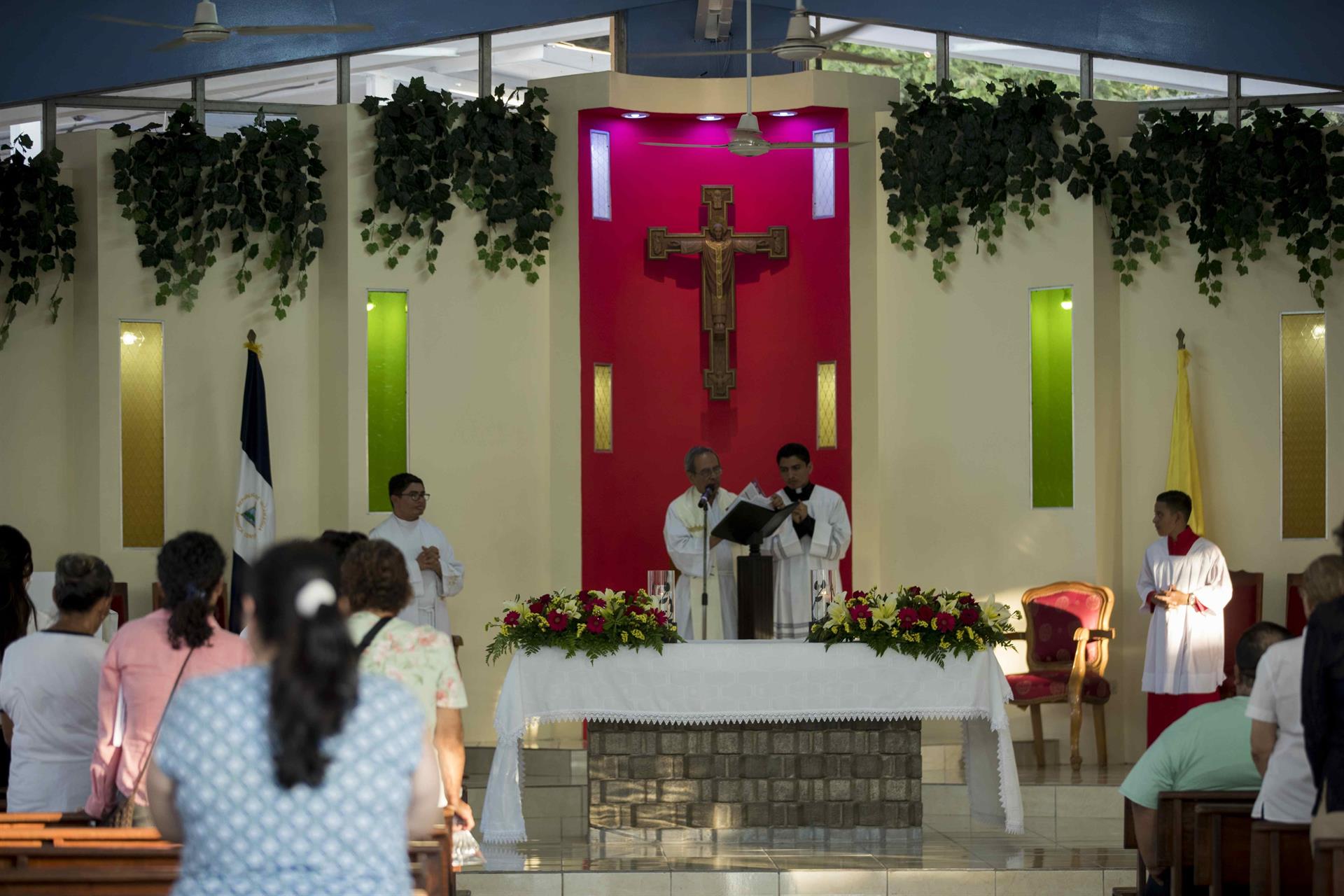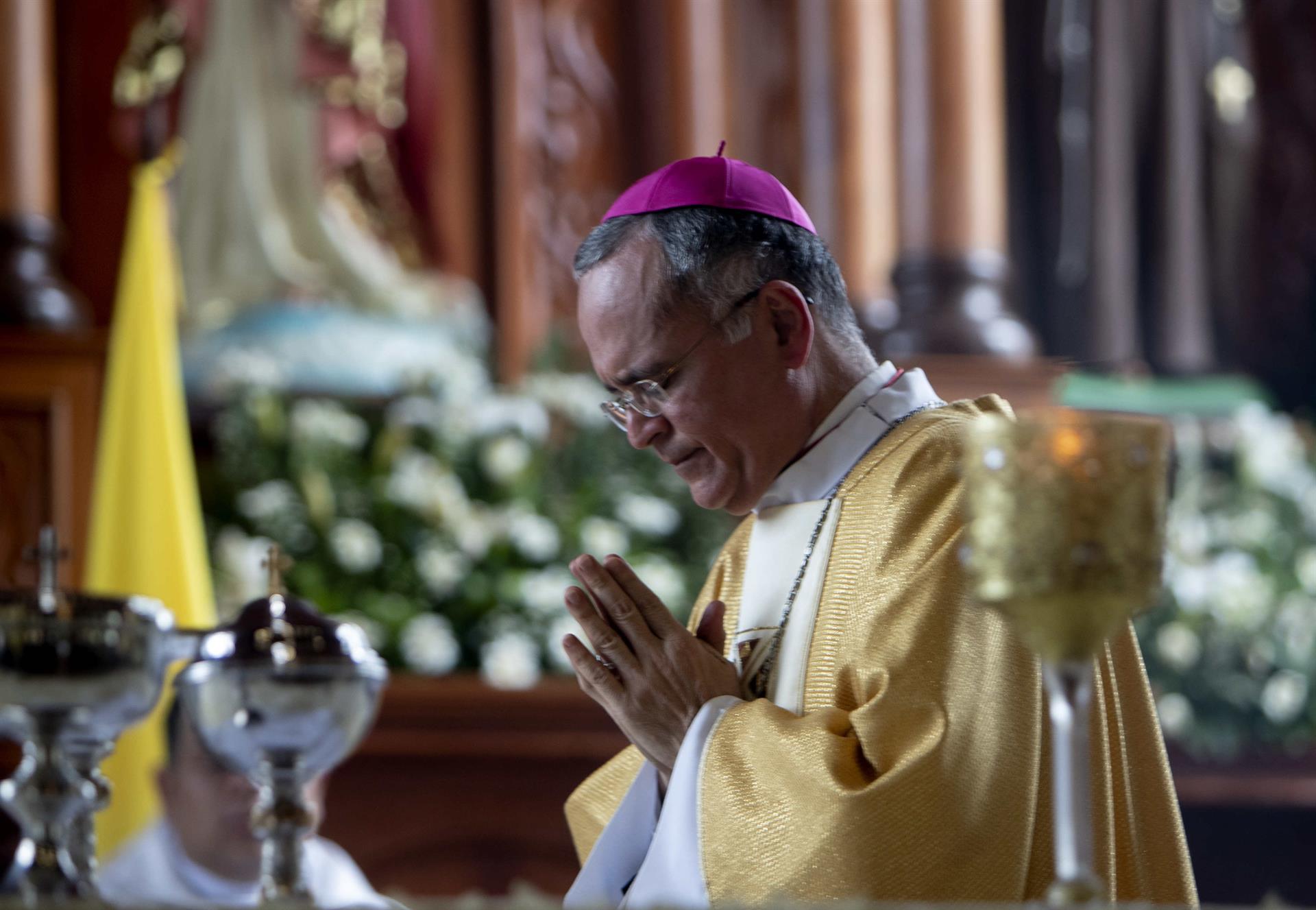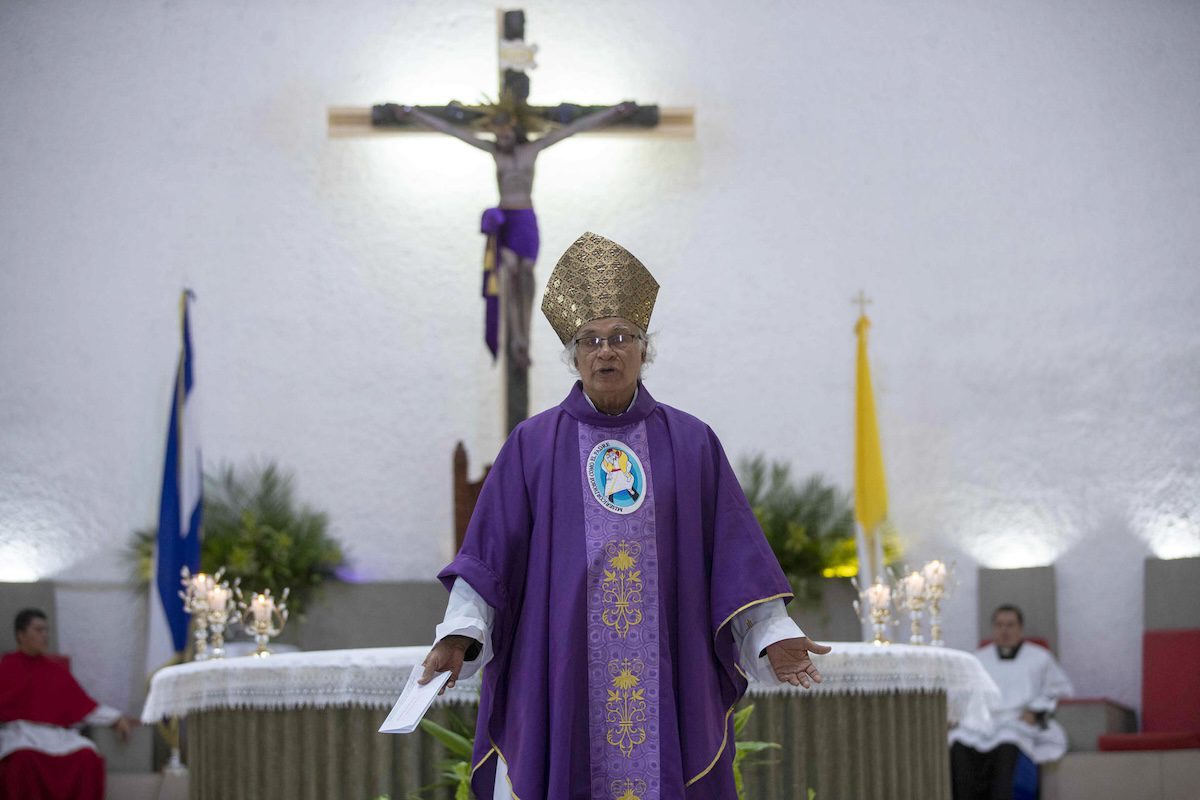The banishment imposed by the Ortega-Murillo dictatorship on 19 Catholic members of the clergy, including Bishops Rolando Alvarez and Isidoro Mora Ortega on January 14, was a devastating blow to the Catholic Church in Nicaragua, since several of these priests held key positions in the ecclesiastical administration.
The attack has been felt with greater emphasis in the Archdiocese of Managua: among those banished are two vicars, the chancellor, the bursar, an exorcist, and even the bilingual parish priest who was in charge of the curia’s schedule and of Cardinal Leopoldo Brenes, the cardinal who heads this Catholic jurisdiction, the most important in the country.
The religious with key positions in the Archdiocese of Managua were also a national reference, since they were well-known in the media and “very beloved among the clergy”, according to several sources close to the Catholic Church consulted by DIVERGENTES for this article.
“The government basically decapitated the Archdiocese of Managua, with the exception of Cardinal Brenes. They banished priests who held key and operative positions. What they did was to expel, so to speak, the most thoughtful people, with more preparation”, says a source linked to the capital’s curia.
The most notable banished from the Archdiocese of Managua
Among the key positions that have been banished is Bishop Carlos Avilés, vicar general of the Archdiocese of Managua, and one of the most active voices in the Catholic Church in the midst of the religious persecution. Bishop Silvio Fonseca, vicar of the family and youth, and who, before being imprisoned, had his passport withheld and was prevented from leaving Nicaragua in November 2021.
Bishop Miguel Mántica was first pastoral vicar, and then in charge of the 50th Jubilee of Cardinal Brenes in 2023. He is another member of the clergy well known in the country for his criticism of the Ortega-Murillo dictatorial drift. ” Bishop Mántica is another priest who is very loved by all the clergy, not only by the people. They respected him so much that he was assigned specific tasks and many of them were assigned by the Cardinal”, says the clerical source.
Another fundamental position for the Archdiocese of Managua was Father Héctor Treminio, the bursar, that is to say, the man in charge of finances and the curia’s administrator.
“That is a very delicate and important position that cannot be appointed to just anyone. As far as we know, Cardinal Brenes has not yet been able to put anyone in his position. Father Treminio was called ‘Bob the builder’ in the Archdiocese, because wherever he went he made everything new. He was in charge of building the wall of the Cathedral of Managua, and he also rebuilt the parish he was assigned to. Father Treminio had an excellent way of managing the archdiocese’s goods”, describes another source close to the clergy.
Banished priest suffers the effects of the regime’s dungeons
Bishop Pablo Villafranca was the chancellor of the capital’s curia and is currently facing a complicated health condition in Rome, due to his time in the cells of the Ortega-Murillo family.
The sources point out that another religious fundamental to the functioning of the Archdiocese of Managua was Father Raúl Zamora, parish priest of the Divine Mercy Church in Managua, the same temple that in July 2018 was riddled with bullets by police and paramilitaries. A brutal attack in which young Gerald Vazquez and Francisco Flores were killed.
“Father Zamora speaks English and attended all the international calls of the Archdiocese, as well as Cardinal Brenes’ schedule,” ecclesial sources assure.
“Father Ismael Serrano was for a long time the exorcist of the curia of Managua and, although he no longer had such a transcendental function due to his health condition, he was an extremely beloved figure. When he was kidnapped it was a hard time for everyone,” describes the source linked to the curia.
However, the exorcist position is still vacant, since that function was carried out by Father Rodolfo Lopez, but in December 2023 he fled into exile, after the police came looking for him at his parish because he was going to be arrested
Diocese of Matagalpa also hit by the dictatorship

Another diocese hit by the banishment of these members was that of Matagalpa, that is, the diocese of Bishop Rolando Alvarez, the pastoral voice that bothers the presidential couple the most. The vicar general, Father Óscar José Escoto, and Jader Danilo Guido, second vicar of the Cathedral of St. Peter the Apostle, were banished.
“As can be seen, many of these priests, not all of them, showed their faces, spoke… even the Cardinal himself entrusted them with missions or to give an interview; to show their faces for him and now they are banished”, insists the source linked to the Archdiocese.
| The 19 church members banished to Rome by the Ortega-Murillo dictatorship on January 14, 2024 | ||||
| Name | Position | Jurisdiction | Replacement | |
| 1 | Bishop Silvio Fonseca | Family and youth vicar | Archdiocese of Managua | |
| 2 | Bishop Miguel Mántica | Former pastoral vicar and responsible of Cardinal Leopoldo Brenes’ 50th Jubilee | Archdiocese of Managua | |
| 3 | Bishop Carlos Avilés | Vicar general | Archdiocese of Managua | José Ramón Alemán, foreign vicar from Managua’s occident |
| 4 | Bishop Pablo Villafranca | Chancellor | Archdiocese of Managua | Miguel Toruño, of the Santa Ana church in Niquinohomo |
| 5 | Father Héctor Treminio | Archdiocese bursar and curia administrator | Archdiocese of Managua | |
| 6 | Father Ismael Serrano | Former exorcist | Archdiocese of Managua | |
| 7 | Father Raúl Zamora | Priest of the Divina Misericordia church and secretary of the curia | Archdiocese of Managua | Orlando Ruiz, recently ordained priest |
| 8 | Father Óscar José Escoto | Vicar general of the Matagalpa diocese | Archdiocese of Matagalpa | |
| 9 | Father Mykel Monterrey | Priest of the Nuestra Señora de Candelaria church | Archdiocese of Managua | |
| 10 | Father Gerardo Rodríguez | priest of the Purísima Concepción church | Archdiocese of Managua | |
| 11 | Father Jader Hernández | Priest of the Divino Pastor church | Archdiocese of Managua | |
| 12 | Father Marcos Díaz | Priest of the Santo Tomás Apóstol church in Corinto | Archdiocese of Leon | |
| 13 | Father José Gustavo Sandino | Priest of the Nuestra Señora de Dolores church | Archdiocese of Jinotega | |
| 14 | Father Fernando Calero | Priest of the Nuestra Señora de Fátima church | Archdiocese of Matagalpa | |
| 15 | Father Jader Danilo Guido | Second vicar of the San Pedro Apóstol catedral | Archdiocese of Matagalpa | |
| 16 | Bishop Rolando Álvarez | Bishop | Diocese of Matagalpa and Esteli | |
| 17 | Bishop Isidoro Mora Ortega | Bishop | Diocese of Siuna | |
| 18 | Alester Sáenz | Conferee | Siuna | |
| 19 | Tony Palacios | Conferee | Paiwas | |
Cardenal Brenes appoints replacements for banished priests
The sources consulted by DIVERGENTES reported that Cardinal Brenes has already begun to restructure the Archdiocese of Managua, but has not been able to fill all the key spots left by the banished.
On February 7, 2024, less than a month after the clerics were sent to Rome on a flight by the Venezuelan airline Conviasa, the cardinal appointed priests José Ramón Alemán and Miguel Toruño as the vicar general and chancellor of the Archdiocese of Managua, respectively.
This way, Bishops Avilés and Villafranca were replaced. The sources also report the replacement of Father Zamora – the bilingual one – as the secretary of the curia. Orlando Ruiz, a priest recently ordained in August 2023, was appointed in his place.
“As far as I know, Father José Ramón, who holds Bishop Avilés’ position, has some studies. But the young man who replaced Zamora has no special studies because he has just been ordained. We don’t know who the bursar will be, and in my opinion, the cardinal has appointed people just to fill the positions,” says the source linked to the curia.
Less critical and more “obedient” priests

However, another source close to the Catholic Church for many years has a different opinion about the appointments being made by Cardinal Brenes.
“These appointed priests do not have experience or qualifications for the assigned positions, but I suppose they will acquire them as years go by. But I can assure you that the dictatorship wants to get rid of any priest over 45 years old because it is difficult for the cardinal to influence them; they are already formed and will not change their opinion,” he asserts.
In that sense, the source close to Nicaraguan Catholicism continues, “Cardinal Brenes could assign tasks to the banished religious, but he couldn’t make them change their “way of being,” much less their critical positions against the Ortega-Murillo regime.
“While these young men coming out of the seminaries, who are being ordained, owe loyalty to Brenes. So, whatever the cardinal says to them, it will be like the word from God. I know that the cardinal has asked these priests not to communicate with problematic individuals who criticize religious persecution,” emphasized.
Discontent with Cardinal Brenes

In addition to the sources consulted for this article, DIVERGENTES has been talking to different priests in exile and within Nicaragua for months. All share discontent with Cardinal Brenes. They argue that the cardinal does very little or nothing to defend them and the church from the attacks of the Ortega-Murillo regime.
A parish priest from the Archdiocese of Managua recounted that his temple is surrounded daily by police, who take photos even “of the church’s toilet.”
“The police enter daily, and it drives me crazy. I can’t take the pressure anymore, and when I told Cardinal Brenes he didn’t listen. He does nothing,” says the priest. Another priest from León shared a similar experience but referring to Bishop Socrates René Sándigo.
“One sends messages to Bishop Sándigo, telling him about the horrible pressure we are under, but he leaves us on ‘seen.’ But you know, one must respect and be loyal to the bishop, so you can’t say much,” says the priest assigned to a church in León.
A source at the Vatican consulted by DIVERGENTES says that to date, Cardinal Brenes has not even contacted the 19 expelled religious.
“Really, the shared sentiment is that the position was too big for Cardinal Brenes. He hasn’t even called Rome to inquire about the health status of the two priests who came ill from Nicaragua. If you compare him to the late Cardinal Obando y Bravo, who despite being an ally of the dictatorship until his death, in the eighties did more than Brenes to defend the Church from the attacks of the Sandinistas. He was more assertive,” said the source.
Influence over Brenes
Cardinal Brenes has rejected criticisms against him on different occasions and usually blames the media for publishing such information. Sources from the Archdiocese of Managua agree that while the cardinal is a capable person, “he is quite influenced by people like Lázaro Gutiérrez Bolaños, one of his assistants in the press office of the Archdiocese.”
“Lázaro Gutiérrez informs the cardinal about everything, and he himself has made clear his connection with one of the personal photographers of Daniel Ortega and Rosario Murillo,” says one of the sources close to the capital’s curia.
Indeed, according to a Facebook post by the cardinal’s assistant in November 2018, he “clarifies” his closeness to César Pérez, one of the main photographers of the presidential couple, due to the recurring distrust surrounding him.
“My loyalty to the Church is not in doubt. Regarding my closeness to César Pérez, I want to make the following clear,” wrote Gutiérrez Bolaños. “César is more than my business partner; he is like a brother to me and my family. We have been working together since 2003, when he didn’t even work for the Presidency, and I didn’t work for the Archdiocese. We used to seek private events to bring food to our tables (…) today, we continue to seek private events to cover our personal and family expenses.”
The request to the banished priests: “It is not appropriate to speak”

In recent weeks, suspicions about the silence regarding the exile of the 19 Catholic religious have prevailed. Since they arrived in Rome, neither Bishop Álvarez nor his fellow habit-wearers have publicly spoken about their experiences in the regime’s prisons. The source at the Vatican consulted by DIVERGENTES stated that the banished were not ordered to be silent because it is not the Church’s style, but they were advised that “it is not appropriate to speak.”
The reasons from the Holy See are diverse, but they particularly aim to ensure the safety of the priests remaining in Nicaragua and seek a way for the Catholic faith to continue being practiced. According to clerical sources in Managua, Cardinal Brenes has also suggested to parish priests not to say anything about the sociopolitical situation and religious persecution they endure.
Days after the exile of the 19 clergymen, the exiled bishop in Miami, Silvio Báez, traveled to Rome and had a papal audience. Upon his return to the United States, it was reported that Báez would be absent “for several weeks” from his Sunday masses at Santa Agatha in Miami, where he often criticizes the Sandinista regime in his homilies.
There were speculations that the Holy See also advised Báez that “it was not appropriate to speak,” but associates of the bishop explained that the Lenten season tends to be a busy time for him. On various occasions, the bishop has declined interviews with DIVERGENTES.
“He has various retreats,” said sources close to Báez. On the night of February 20, Báez announced that he is traveling to Italy again to lead spiritual exercises at Carmelite houses. So the silence from the atrium of Santa Agatha will temporarily continue.





